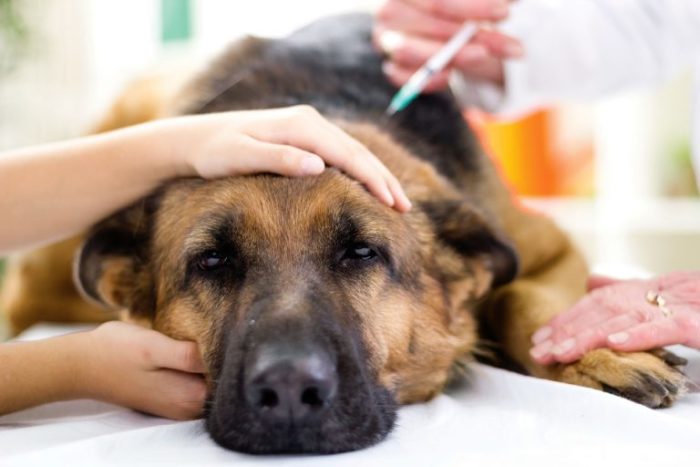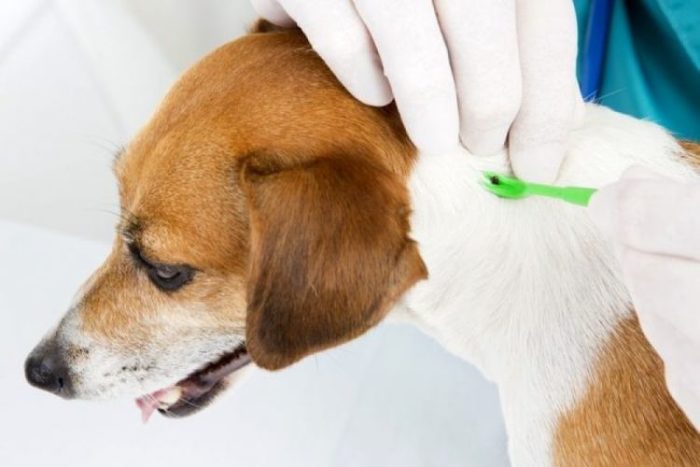With the onset of spring and until late autumn, all owners share a common headache: “How not to miss symptoms of pyroplasmosis in dogs?”. He turned away from the delicious, long sleep, does not want to walk, drink a lot – panic! How much strength and nerves it takes to ensure that no nasty mite crawls into the pet’s fur, and all the same queues in the clinics are never-ending: droppers, long recovery, and sometimes death …
Contents
Under the microscope
Babesia is a microscopic cellular parasite that is spread all over the world. There are many species and sub-species of babesias that cause disease in mammals. Since complications after pyroplasmosis in dogs are extremely difficult, it is important to make every effort to prevent the development of the disease. And for this it is necessary to fight with mites – carriers of pyroplasms (babesias).
Nasty mites, by the way, do not suffer from pyroplasm at all. And even pass the parasites to their offspring, which means that to become a carrier, a tick does not have to bite a sick dog. Babesia is found in the stomach, intestines, ovaries, but most importantly – in the salivary glands and saliva of ticks.
In the process of feeding the mite penetrates deeper into the skin, drains blood and injects it back into the wound, and then sucks again. Blood mixes with saliva – babesia is able to penetrate the dog’s body. The first signs of pyroplasmosis in dogs appear when the number of parasites reaches a certain level, that is, the incubation period varies greatly. If it is a young healthy dog, and a small amount of babesies get into the body with the saliva, the disease will manifest itself after several weeks if the pet is attacked by a lot of infected mites and / or the health of the pet is weakened, the symptoms of pyroplasmosis in dogs appear only two to three days after the bite.
So, the babesia got into the bloodstream. Freely moving, they “meet” on their way red blood cells, get inside, feed on their contents (hemoglobin) and multiply inside the cell by dividing. When the erythrocyte is completely emptied, the babesia breaks through the cell membrane, exits into the bloodstream and finds a new victim – the erythrocyte-free parasite. A group of devourer cells (macrophages) immediately respond to the invasion, capture the affected red blood cells and destroy them (phagocytosis). But the babesians do not perish in the process, and, like the snake-fish, travel the body “on horseback” on macrophages, which contributes to an even faster development of the disease.
What is so dangerous pyroplasmosis?
The processes of introducing babesies into the cage, feeding, dividing and searching for a new red blood cell occur fairly quickly, and throughout the body. Erythrocytes perish massively, macrophages do not have time to destroy all affected cells at once. If you recall the school course of anatomy, the consequences of pyroplasmosis in dogs acquire frightening proportions:
- erythrocytes deliver oxygen to tissues and “take” carbon dioxide from tissues, that is, they are responsible for “cellular respiration”. Few red blood cells – little oxygen, the cells literally choke;
- deceased red blood cells should be removed from the body, otherwise death from intoxication will occur. The kidneys, liver, and spleen are involved in the process, which have to work “overtime”;
- groups of dead erythrocytes form thrombi that clog the kidney tubules. As a result – kidney failure.
In addition, acute and chronic pyroplasmosis in dogs is a constant load on the respiratory and cardiovascular systems: because of the decrease in the number of red blood cells, the heart and lungs are working for wear, trying to compensate for the lack of oxygen and eliminate the excess of carbon dioxide in the cells of tissues.
Symptoms
Since it is easier to treat pyroplasmosis in dogs, the earlier the owner notices the signs of an illness, in the period from spring to late autumn, one should pay special attention to the pet. If the active dog yesterday “for no reason” refuses to play, drinks a lot, does not eat well, looks sluggish and “nothing interesting” – running to the clinic. Perhaps the pet is sick from the heat or just decided to rest from the bustle, but in the case of pyroplasmosis, time plays a huge role!
Unfortunately, even the most caring owners rarely notice the disease at an early stage. Often, illumination occurs when a pet is aiming at a pillar with frighteningly red, brown or black urine. If the owner has not developed a useful habit to always examine the urine of the pet (ie, realized later than it could), acute pyroplasmosis in dogs shows the following symptoms:
- yellowness or pallor of mucous membranes;
- complete refusal of feed, strong thirst;
- a sharp rise in temperature;
- full of apathy;
- dyspnea;
- diarrhea and / or vomiting, sometimes with an admixture of blood.
Symptoms can vary in severity or completely absent for a long time. Pyroplasmosis – an insidious disease that can kill a young active pet for a couple of days! Every hour more and more cells die, rapidly increases into intoxication, the body weakens. To restore the dog after pyroplasmosis has not dragged on for years, you need to contact the veterinarian at the slightest suspicion! Without treatment more than 90% of pets die, and about half of dogs die from the consequences of intoxication, if the disease is diagnosed at later stages.
In addition to acute, there is chronic pyroplasmosis in dogs – a rare form of the disease, in which babesia is so inactive that the pet feels completely normal. However, during a period of stress, parasites can become more active, leading to the appearance of typical symptoms.
Diagnosis and treatment
Suspected of something wrong, you need to donate blood for research as soon as possible. Babesius is not always found, especially if the parasites do not multiply, so it is advisable to take two blood samples taken from different places (the veterinarian will most likely make big eyes, but insist on his own). Urgent analysis for pyroplasmosis in dogs will be ready in an hour and a half, usual – only the next day. In connection with the specificity of the disease, it is highly desirable to pay for express analysis (a full-scale laboratory test, rather than the express test for 20 min, which is negative even with obvious clinical symptoms).
If the diagnosis is confirmed, the veterinarian will decide how to treat pyroplasmosis in the dog, based on the severity of the symptoms and the results of subsequent tests (total and blood biochemistry, number of parasites in the blood). Avoid physicians who offer standard schemes! Grab the dog and take it to the best available clinic, since the treatment of this ailment is extremely important individual approach.
The main task is to cope with the consequences of pyroplasmosis in dogs and the consequences of using drugs that kill babesies. After the introduction of heavy poisons that destroy parasites (pyrostop, berenil, imidosan, etc.), the animal becomes worse – the blood is literally poisoned by dead decomposing babesias and dead cells, kidneys and liver, cardiovascular system, immunity works at the peak of possibilities. To help the body cope with intoxication, prescribe maintenance therapy: hepatoprotectors (necessarily on a plant basis), vitamins, gamavit, saline solutions, cardiac drugs, etc. In many respects depends on its effectiveness, how difficult it is to restore the dog after pyroplasmosis. Of course, it is very important, at what stage is the disease discovered and what is the general condition of the pet.
It is important to remember that pyroplasmosis affects the kidneys and liver, and therefore you need to develop a special menu. As a rule, raw fruits and vegetables are removed from the diet, they reduce the amount of fats and proteins, enter the menu of sour-milk products (without fanaticism). To shorten the period of recovery of a dog after pyroplasmosis, it is necessary to check the heart, kidneys, liver, respiratory and immune systems. Biochemistry of blood and urine is taken every two to three weeks to monitor the dynamics. Based on the results of the tests, the doctor cancels or adds one or another medication to maintain the function of a particular organ. Again, there can not be any schemes, only an individual approach.
Unfortunately, even with timely access to a veterinarian, quality treatment and a thoughtful approach to therapy, complications after pyroplasmosis in dogs are not excluded:
- renal and hepatic impairment;
- ischemic brain damage;
- cardiac and pulmonary insufficiency;
- immune deficiency;
- pancreatitis.
To reduce the severity of the consequences, veterinarians use plasmapheresis: the blood is “distilled” through a special filter, on the membrane of which the dead erythrocytes and babesia settle. At the same time, the liver and kidneys remain almost “clean”, and suffer less during the intoxication and excretion of toxins from the body. But this procedure is not available in all clinics.
Prevention
To the joy of the owners, a vaccination against pyroplasmosis for dogs has recently appeared, which seems to have been a real rescue: a couple of injections, and you can forget about the terrible disease. However, expectations were not met: the vaccine does not protect against pyroplasmosis in general, only reducing the severity of the disease.
If you think about it, nothing is surprising, because babesia is not a virus, it is a parasite. What kind of immunity can we talk about? After vaccination, the organism of the pet is not protected in any way, but for half a year a medium is formed in the blood, which is not suitable for the active reproduction of babesias. Therefore, the vaccine against pyroplasmosis for dogs is not a vaccine in essence, but an attempt to reduce the number of deaths. However, this was not possible: vaccinated dogs become ill, but the symptoms are blurred and nonspecific, which complicates the diagnosis. In addition, the drug is toxic and has a harmful effect on liver and kidney tissue.
Therefore, the best prevention of pyroplasmosis in dogs is still the fight with ticks. Spray, collars, drops – at the discretion of the owner. The main thing is that from the moment of the first thaws to the moment when the subzero temperature sets, the pet was protected from tick bites. After walking on nature, be sure to inspect the dog. Living in a private sector, the antiparasitic treatment of the adjacent territory is not superfluous, but it is better to entrust it to a specialist.


















